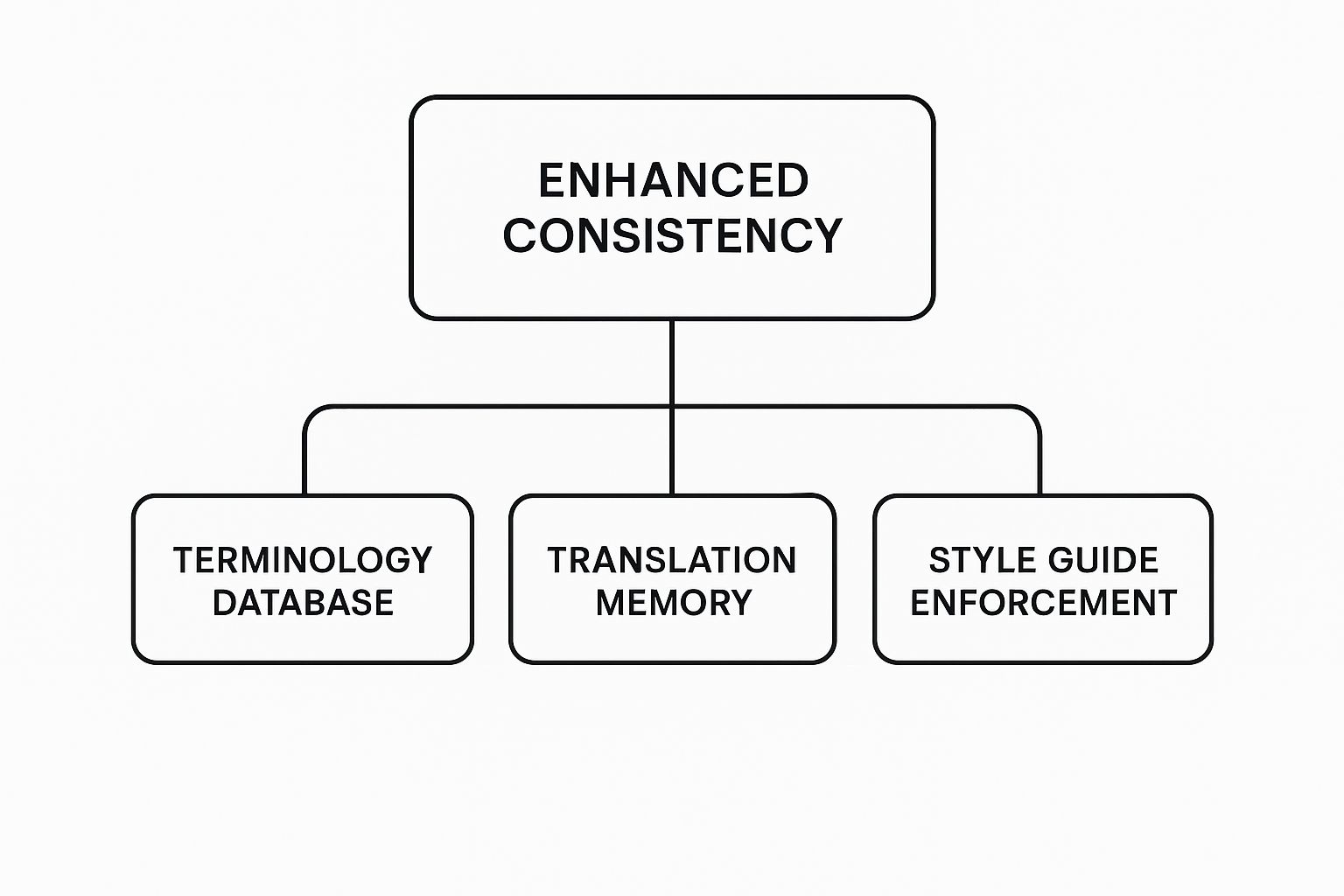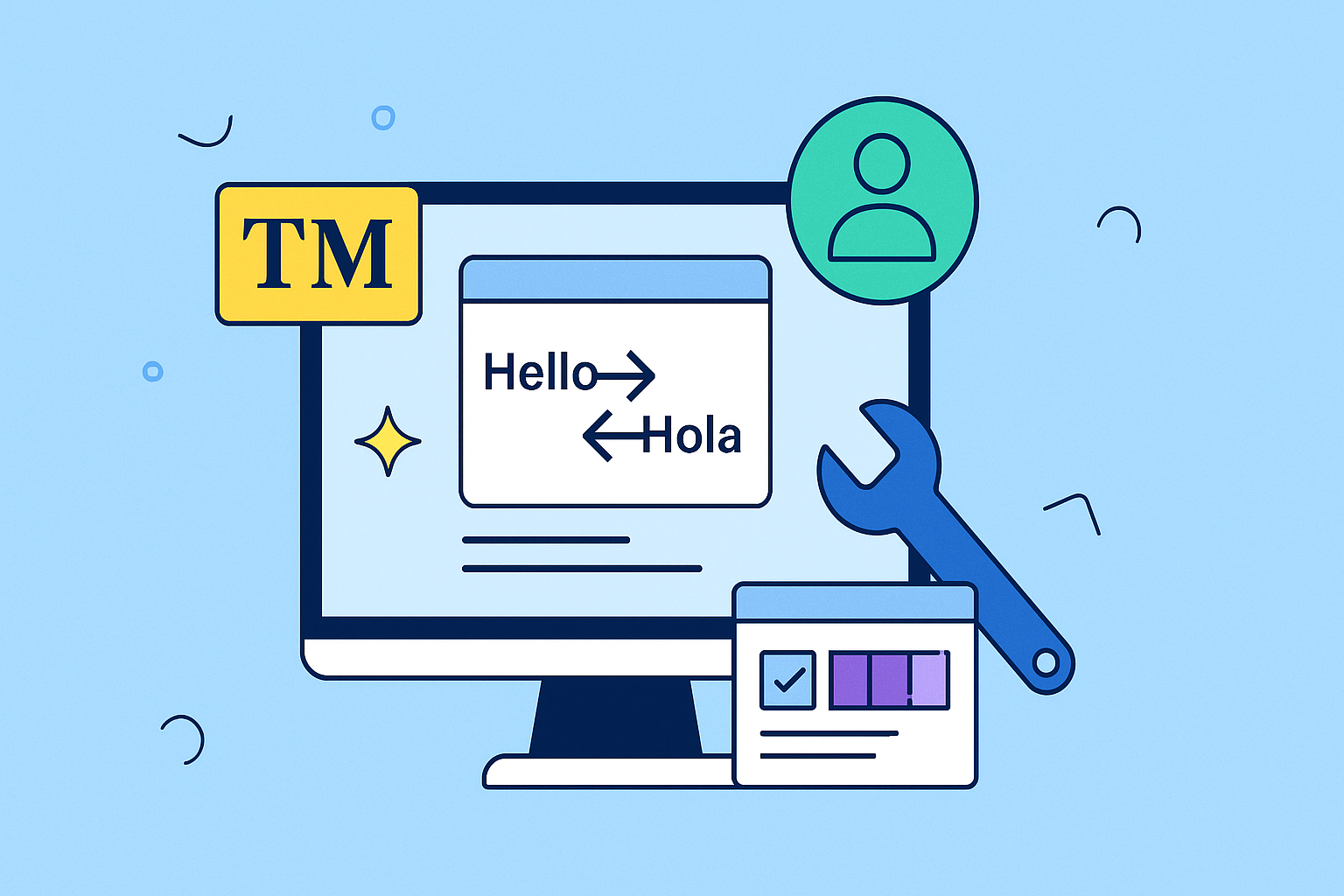When we talk about the advantages of computer-assisted translation, we’re really talking about a powerful partnership between human linguists and smart software.
Think of it this way: you wouldn’t ask a master chef to cook a gourmet meal in a messy, disorganized kitchen. A CAT tool is like giving that chef a perfectly prepped station with every specialized tool right at their fingertips. It doesn’t cook the meal for them, but it lets them create incredible dishes with far greater speed and precision.
This technology is all about augmenting human expertise, making global communication more efficient and consistent across the board.
What Is Computer Assisted Translation
At its heart, a Computer Assisted Translation (CAT) tool is a software platform built to help a human translator work more effectively. This is a crucial distinction. It’s completely different from fully automated machine translation, like what you get from Google Translate. Instead of replacing the linguist, a CAT tool acts as their digital assistant, handling the repetitive, tedious tasks so they can focus on the real challenges: the nuances of language, context, and tone.
Imagine you’re tasked with translating a 50-page user manual. Without a CAT tool, you’d be translating every single sentence from scratch. With one, the software intelligently remembers everything you’ve already done.
How CAT Tools Empower Translators
The whole process usually kicks off when a translator uploads a document. The CAT tool then breaks the content down into manageable segments—typically sentences or phrases—and displays the original text right alongside the empty field for the translation. This side-by-side view is where the magic really starts to happen. The platform strips away all the complex formatting, allowing the linguist to focus purely on the words.
The main advantages come from a few key components:
- Translation Memory (TM): This is essentially a database that stores every single segment a translator has ever approved. The next time the same sentence (or a very similar one) pops up, the TM instantly suggests the existing translation. No need to re-translate the same thing twice.
- Terminology Base (TB): Think of this as a custom glossary or a “brand dictionary.” It ensures that key terms—like product names, marketing slogans, or specific technical jargon—are always translated the same way, every single time.
This human-in-the-loop approach is what ensures high quality while giving productivity a massive boost. For businesses that live inside platforms like Jira, integrated solutions can bring these benefits directly into their existing support workflows. You can see a great example of this by exploring how to manage issue translation for your service desk. It’s this powerful synergy between human skill and technological efficiency that makes modern localization so effective.
Accelerate Timelines with Unmatched Speed

In any global market, speed is a serious competitive advantage. One of the biggest wins you get from computer-assisted translation is a massive cut in project timelines. This isn’t just about translators working faster; it’s about fundamentally changing how the work gets done by wiping out repetitive tasks.
The engine driving this whole process is the Translation Memory (TM). Every time a translator finishes and approves a sentence, the TM saves it. The next time that exact sentence shows up—whether in the same document or a new one down the road—the CAT tool pulls that perfect translation instantly. No more translating the same thing twice.
This is a game-changer for content that’s full of repetition. Think about:
- User Manuals: Safety warnings and instructions are often identical across different product lines.
- Website Updates: Things like headers, footers, and standard calls-to-action almost never change.
- Software Interfaces: Button labels and system messages need to be consistent everywhere.
Working Smarter, Not Harder
Picture this: you’re updating an instruction manual for a new product model. Instead of starting from scratch, a translator using a CAT tool can instantly apply all the 100% matches from the old version’s TM. This frees them up to pour all their energy into what’s actually new, slashing the project time.
This kind of efficiency is exactly why the CAT software market is booming. Projections show it growing from $249 million USD in 2025 to a staggering $448 million USD by 2033, all because businesses are desperate for faster, smarter workflows.
By reusing past work, businesses can get products, campaigns, and updates into international markets way ahead of schedule. Faster turnarounds mean faster time-to-market, which translates directly to seeing revenue sooner.
When you automate the grunt work, you let your human experts focus on what they do best: adding the linguistic finesse and cultural nuance that software just can’t replicate. It’s all about scaling your multilingual operations without giving up on quality.
For a closer look at how this impacts the bottom line, check out our report on automatic translation for business.
Maintain Perfect Brand Consistency Worldwide
Is your brand’s voice unmistakable, no matter the language? This is where computer-assisted translation really shines—by enforcing consistency on a global scale and protecting your brand identity in every single market.
Without this control, you’re opening the door to customer confusion, a watered-down message, and even legal headaches from mistranslated terms. It’s a risk you can’t afford to take.
The Power of a “Brand Dictionary”
At the heart of this consistency is the terminology base (TB). Think of it as a centralized “brand dictionary” for your entire organization. But it’s much more than a simple glossary; it’s a dynamic database that dictates the exact translation for your most critical terms, every single time.
This includes things like:
- Product and feature names that absolutely must stay the same.
- Marketing slogans and taglines that carry your unique brand equity.
- Industry-specific jargon that needs precise, pre-approved wording.
By locking these terms in, CAT tools eliminate the guesswork. You’re no longer hoping for consistency—you’re guaranteeing it, and preventing costly branding mistakes before they happen.
How CAT Tools Guard Your Brand
Maintaining a consistent voice is built on a few key technological pillars. Inside the CAT tool, these features work in harmony, acting as a digital guardian for all your translated content.
This infographic breaks down how the core components of a CAT tool come together to achieve rock-solid consistency.

As you can see, features like terminology databases, translation memory, and style guide enforcement are the essential supports for brand integrity. This growing reliance on accuracy and consistency is fueling massive market expansion.
The global Computer-Aided Translation software market was valued at $588.73 million USD in 2025 and is projected to skyrocket to $1,560.32 million USD by 2032. This surge is directly driven by the enterprise demand for accuracy. You can dive deeper into the trends of this rapidly growing market on MarketResearch.com.
Beyond the termbase, built-in Quality Assurance (QA) checks are the secret weapon. They automatically scan translations for any deviations from approved terminology, numerical mismatches, or inconsistencies with previously translated content. These automated checks act as a final safety net, flagging potential issues long before they ever reach a customer. This is how you ensure every single piece of content perfectly aligns with your brand’s high standards.
Drive Real Cost Savings on Every Project

Beyond just moving faster, one of the biggest wins with computer-assisted translation is the direct, measurable impact on your bottom line. This isn’t some fuzzy, hard-to-track benefit. The cost savings come directly from a core feature: Translation Memory (TM).
Think of TM as a cost-control engine that gets smarter with every project. Instead of paying full price to translate the same sentence over and over again, you pay less—or sometimes nothing at all—for content you’ve already handled. This creates a crystal-clear return on investment. As your TM database grows, your long-term localization costs shrink, letting you do much more with your budget.
How Translation Memory Reduces Your Bill
Translation providers almost always structure their pricing around TM match rates. It’s a tiered system that directly rewards you for consistency, creating a powerful incentive to reuse previously translated content.
Here’s how it usually breaks down:
- 100% Matches: When a new sentence is identical to one already in your TM, you’ve got a perfect match. For these, you’ll pay a heavily reduced rate, if anything.
- Fuzzy Matches: For sentences that are similar but not quite the same, the TM will flag a “fuzzy match.” The translator only has to edit the small differences, and you pay a discounted rate based on how close the match is.
- New Words: You only pay the full, standard per-word rate for brand-new content that has no existing match in the memory.
This structure means that updating a product manual or a website becomes exponentially cheaper over time. You are effectively recycling your previous investments to reduce future expenses.
This same principle of efficiency is what makes machine translation (MT) so powerful for cost-cutting. Valued at $1,214.86 million USD in 2024, the global MT market is on track to nearly triple by 2032. Why? Because it automates the translation of high-volume, repetitive text, drastically reducing manual labor costs.
This is an approach we’ve explored in detail in our insights on automatic translations. By letting technology handle the repetitive stuff, you free up your human experts to focus their brainpower on the complex, nuanced work where they truly add value.
4. Better Collaboration for Global Teams
At its heart, localization is a team sport. One of the biggest advantages of a computer-assisted translation tool is how it completely changes the game for global teams working together. Think of modern, cloud-based CAT tools as a central, unified playing field where everyone operates from the same playbook.
This means no more emailing files back and forth or wrestling with version control nightmares. With a shared platform, multiple translators, editors, and project managers can all access the very same Translation Memory and Termbase in real time. Everyone is perfectly in sync.
A Single, Efficient Workspace
Imagine you’re managing a large website localization project with teams spread across different continents. An editor in Tokyo can instantly see and approve a segment that was translated just moments before by a linguist in Berlin. This creates a seamless, continuous workflow that just wasn’t possible before.
This unified approach simply removes friction and speeds up the entire project from start to finish. In essence, CAT technology is a perfect example of how to streamline business processes using AI automation, ensuring that global teams can collaborate without missing a beat on multilingual content.
This real-time collaboration means feedback is instant, updates are immediate, and consistency is maintained effortlessly across the entire project. The result is a much faster, more agile localization process that can keep up with today’s demanding business needs.
This collaborative power isn’t just for translators, either. It can be embedded directly into other business tools you already use. For example, integrated solutions for platforms like Jira allow global support teams to work together on multilingual customer issues without ever having to leave their main workspace.
You can see this in action by exploring these use cases for a multilingual service desk in Jira, where this exact advantage directly boosts customer satisfaction. It’s clear proof that the collaborative benefits of CAT tools extend far beyond the translation process itself.
Alright, let’s move this from abstract concepts to a real-world scenario. You can really see the power of computer-assisted translation when it’s baked directly into the tools your teams use every single day.
See CAT Tools in Action with a Real-World Example

A perfect case study is Resolution’s Issue Translation for Jira. This app embeds CAT technology right into a global service desk, which is a game-changer for international support teams.
Imagine this: a support agent can read a customer ticket submitted in Spanish, type out a detailed reply in English, and the tool instantly translates it back into Spanish for the customer. The entire conversation happens seamlessly, with support for over 100 languages, all without the agent ever having to leave their familiar Jira workspace.
Integrated Features Driving Real Outcomes
What makes this work so well is that the app brings core CAT tool features directly into the support workflow. Things like translation memory and custom glossaries are built right in. This means every reply is not only fast but also incredibly consistent, always using the correct, company-approved terms for products or policies.
This integration leads directly to some powerful business results:
- Faster resolution times since agents aren’t jumping between different platforms or copy-pasting into a separate translation tool.
- Higher customer satisfaction because customers get clear, helpful support in their own language.
- More efficient global teams that can collaborate and handle inquiries from any region, breaking down language silos.
This shows that CAT technology isn’t just a niche tool for professional translators. It’s a strategic business asset that directly improves how you operate and how your customers see you.
This principle extends beyond customer support, too. Other computer-assisted tools can help prepare content for localization in the first place. For example, a quality Youtube transcript generation service is often the critical first step before translating video content, proving how automation can support the entire localization journey from start to finish.
Got Questions About CAT Tools? We Have Answers.
Let’s clear up a few common questions that pop up when people first encounter computer-assisted translation and how these tools actually work in the wild.
How Are CAT Tools Different from Machine Translation?
The best way to think about it is this: a CAT tool is a professional’s workbench, specifically designed to help a human expert do their job better. It’s packed with features like translation memory and glossaries that help a real, live linguist work faster and keep their translations consistent. The human is always in the driver’s seat, making the final calls on tricky things like nuance and tone.
Machine translation (MT), on the other hand, is the fully automated process you see with tools like Google Translate. It does the whole job by itself. Now, many modern CAT tools do pull in MT as a suggestion, but the key difference is that a human translator is always there to approve, edit, or reject it. The person is central to the process. You can see how platforms like Google Translate for Jira and JSM fit into this kind of professional workflow.
Are CAT Tools Hard to Learn?
It’s true that professional software can look intimidating, but most modern CAT tools are built to be surprisingly user-friendly. The core functions—like using a translation memory to avoid re-translating the same sentence twice—are usually quite simple to grasp. And honestly, the long-term boost in productivity is so massive that it easily makes up for the small amount of time you might spend learning the ropes.
Any initial learning curve is quickly forgotten once you see the immediate jump in efficiency. The tool takes care of the grunt work, freeing up translators to focus on what really matters: quality.
What Kind of Content Is Best for CAT Tools?
Any content with a lot of repetition is where CAT tools really shine. The more repeated phrases you have, the more time and money you save. Think of materials like:
- Technical manuals
- Software UI text and button labels
- Legal documents and contracts
- Frequent website updates
But don’t think they’re only for technical stuff. Even highly creative work, like a new marketing campaign, gets a huge leg up. Using a termbase (a brand-specific dictionary) ensures that your brand’s voice, slogans, and important product names stay perfectly on-message in every single language.
Ready to bring the power of computer-assisted translation right into your customer support workflow? resolution Reichert Network Solutions GmbH offers Issue Translation for JSM, which embeds seamless, AI-powered communication directly into your Jira Service Management instance. Try it free on the Atlassian Marketplace.
